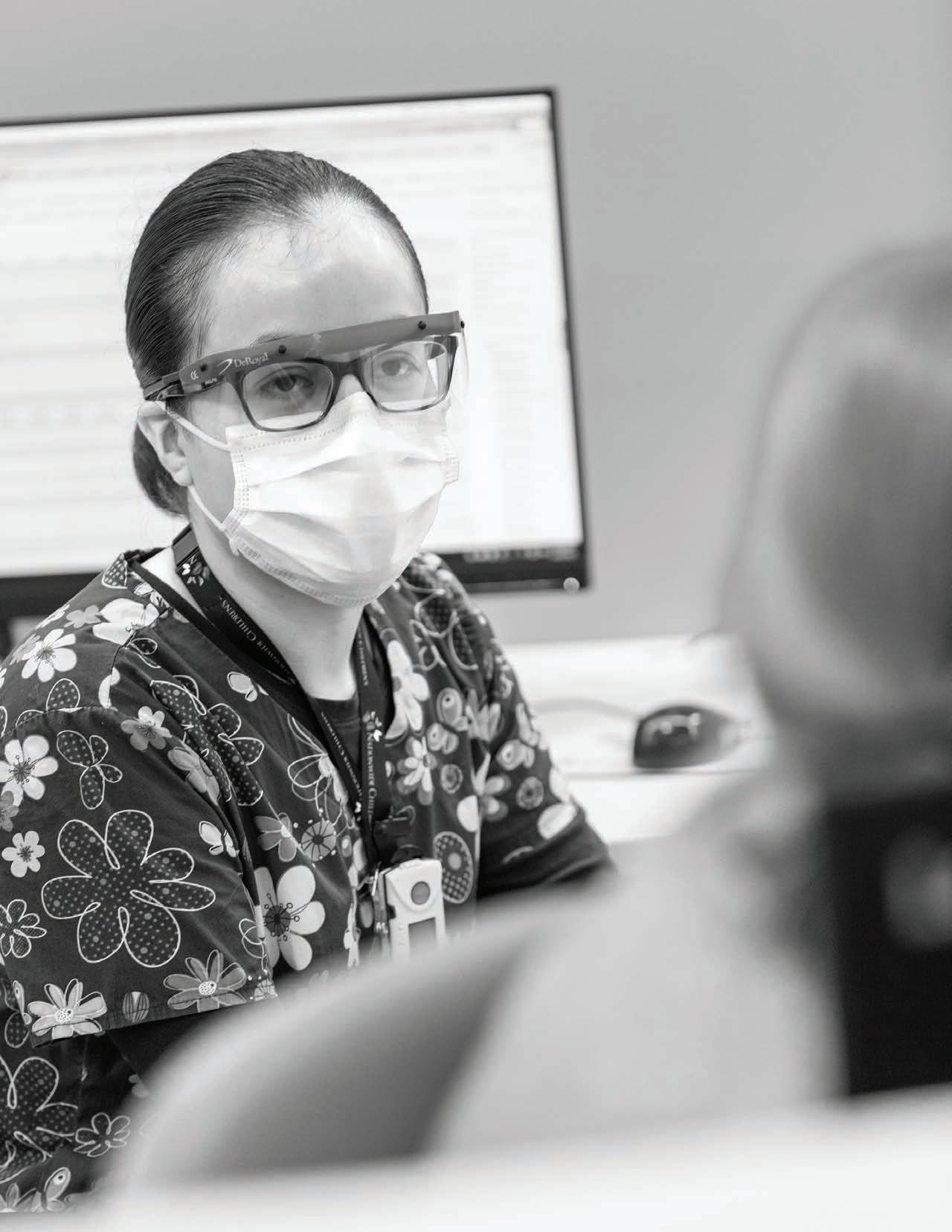
9 minute read
Creating a Culture of Life long Learning
Creating a Culture of Lifelong Learning
Lee Ann Wallace MBA, BSN, RN, NEA-BC
Advertisement
Senior Vice President, Patient Care Services, Chief Nursing Officer Literature (Fonteyn 1994) defines nursing clinical reasoning as the cognitive processes that nurses use when reviewing and analyzing patient data to plan care and make decisions for positive patient outcomes. According to O’Neill et all (2005), for this to happen, it requires a knowledgeable practitioner, reliable information and a supportive environment. For clinical reasoning or critical thinking to thrive, we must continuously refuel our knowledge by having access to timely, applicable, evidenced-based information. We must create a culture that promotes and nurtures these key nursing competencies. This is not just a “once a year” curriculum of The Learning Center modules, or a four-hour skills day experience. Our vision is to create a culture of life long learning, where there is a hunger for new knowledge and a system that facilitates and supports that vision. And ultimately, we can link this core skill to excellent patient outcomes, reducing patient harm, reducing cost of care and maximizing the patient and family experience while in our care.
Within this edition of Everything Matters In Patient Care, you will find multiple examples of team members using critical thinking, innovation and evidenced-based practice. These components are partnered with a spirited inquiry to develop and enhance a supportive environment which achieves best outcomes for our patients, families and team members to thrive and blossom! You will see multiple examples of bringing education to the patient, family and to our nursing teams. This includes the development and certification of our nursing residency program, the refinement of our preceptor programs and individual and team development models. We will also be expanding the roll-out of our Communicate With Me strategy with team-based, multi-disciplinary learning opportunities. Our COVID-19 efforts have created challenges with the timing in several of these areas, but we will continue to bring these forward as we begin to normalize operations.
Education, precepting, coaching and mentoring are all part of the lifelong learning that keeps our nursing practice fresh and thriving. Please take the time to read some exceptional examples of how our team is elevating clinical practice through education!
Transition to Practice: Nurse Residency
Kelsey Merritt, MS, RN and JoAnna Sutton, MSN, RN, Professional Development
With greater patient acuity, shorter lengths of stay and the use of advanced technology, caring for hospitalized patients has become increasingly complex. While nursing programs provide an excellent foundation for new nurses, a gap still exists between their education and clinical practice and for many newly licensed Registered Nurses, the transition into independent professional practice can be overwhelming. This is particularly true for transition into pediatric practice as nursing students have limited opportunities for pediatric experience. Stressful work environments, increased patient acuity and lack of confidence in skill and clinical judgment are likely reasons for decreased satisfaction and increased turnover in new graduate nurses. Nationally, 35% to 60% of newly licensed nurses are leaving their first position within one year.
Nurse Residency Programs (NRPs) began in the early 2000s in response to the demand that nurses be better prepared to manage within complex health care systems and to address the challenge of nurses leaving the profession. In 2010, the Institute of Medicine (IOM) published the ground-breaking report “The Future of Nursing.” One of the recommendations was to implement NRPs to support the transition into professional practice. Multiple national organizations such as the American Association of Colleges of Nursing, the National Council of State Boards of Nursing, The Joint Commission, the Robert Wood Johnson Foundation and the American Nurses Credentialing Center have also endorsed the need for NRPs for newly licensed RNs. While the IOM and other organizations encouraged implementation of NRPs, little direction was given as to how the programs should be designed. Thus, there is variability in NRP structure, length, content and outcome measurements and confusion as to what “Nurse Residency” means.
RN Residency is defined by the American Nurse’s Credentialing Association as a program for currently licensed RNs with less than 12 months of relevant experience. The purpose of residency is to provide continued support to new nurses during their first year of hire as they build the knowledge, skills, attitudes and clinical judgement required to deliver safe, quality care. Residency is not intended to take the place of unit-based orientation or onboarding but rather acts as an additional component in a comprehensive onboarding process.
The Nationwide Children's Hospital Nurse Residency Program began in 2011. It was created by Professional Development with an inaugural Acute Care Cohort of 22 newly licensed RNs. A Critical Care Track was added to the program in 2016. Since 2011, a total of 28 Acute Care Cohorts and 13 Critical Care Cohorts have graduated with more than 800 new RNs benefiting from the program.
NURSE RESIDENCY GROWTH
Number of Residency Participants
160
140
120
100
80
60
40
20
0 2011 2012 2013 2014 2015 2016 2017 2018 2019
Years

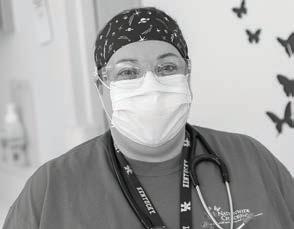
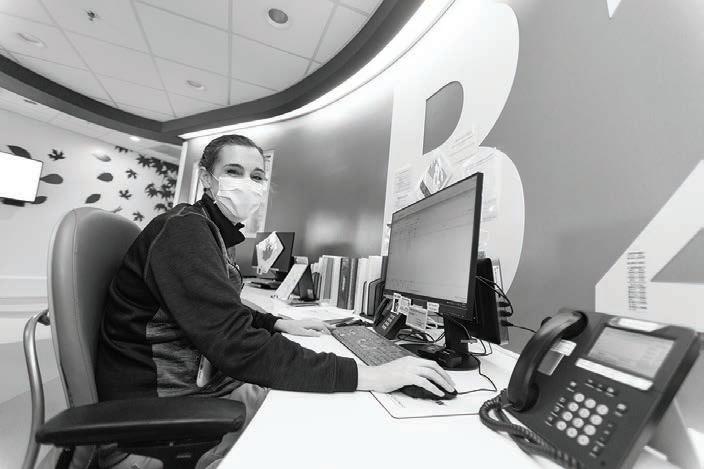


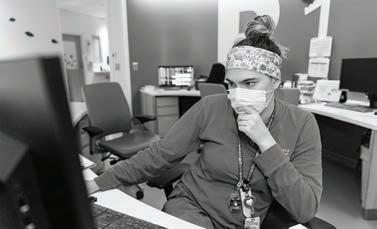
The Nationwide Children's Nurse Residency Program is one year in length. Evidence shows 12 months is necessary to allow adequate time for nurses to adjust to their new professional role. The program helps to move new nurses past a commonly found crisis point five to seven months into their practice. The benefits of keeping nurses in a supportive residency cohort environment during the first year are immense to the institution. Studies show new nurses in residency programs longer than 24 weeks were 21 times more likely to remain employed with the organization than graduates in programs that were 12 weeks or less. This is a major financial savings to the institution as hospitals can lose up to $8.1 million annually from nurse turnover.
UNITS CURRENTLY PARTICIPATING IN NURSE RESIDENCY INCLUDE:
• H2 & H8B Pediatric
Intensive Care • H4A Cardiac Care • H4B Cardiac Intensive
Care Unit • H5A General Surgery • H5B Burn-Trauma • H7A Orthopedics • H8A Pulmonary • H9A General Medicine • H9B Rehab • H10A & H10B NeuroSurg • H11B Endocrine-Renal • H12 Hematology/Oncology • C4A Bronchopulmonary dysplasia Neonatal
Intensive Care Unit • C4B Acute Neonatal
Intensive Care Unit • C5A Behavioral
Health-Gen Med • C5B Infectious Disease • T5A/Behavioral
Health Pavilion • Perioperative Services
Our program at Nationwide Children’s is based on Patricia Benner’s findings about novice to expert practice. The curriculum objectives are developed from the American Nurses Credentialing Center (ANCC) Practice Transition Accreditation Program (PTAP) criteria and standards, competencies from Quality and Safety Education for Nurses (QSEN) project and American Nurses Association (ANA) Standards of Professional Practice. Nationwide Children's Mission, Vision and Values are threaded throughout the curriculum. Evidence-based content includes a focus on safety, patient/family centered care, communication, teamwork and collaboration, organizational enculturation and professional growth. Additionally, time is allotted during the residency meetings for reflection and peer discussion to encourage learning from experiences and to promote group support. Newly licensed nurses from participating units are placed into a cohort based on their start date. Each cohort meets monthly for four hours. On average, Professional Development has five cohorts operating at any given time during the year.
A thorough feedback and evaluation process is essential to ensure that the residency program continues to meet the needs of the nurse residents and the organization; hence data is routinely collected to monitor progress and be responsive to our Residents, as well as, institutional and national priorities.
The Nationwide Children's Nurse Residency Team consists of Kelsey Merritt, MS, RN, Kelsey Harn, MSN, RN, CPN, JoAnna Sutton, MSN, RN and Siobann Stoughton, BSN, RN. The Residency Team is responsible for program development, scheduling, ongoing program evaluation and serving as consultants and mentors for nurse residents throughout their participation in the Nurse Residency Program.
Our short-term goals for nurses participating in the program are to:
• become confident and competent • provide safe patient care • develop clinical leadership • engage in professional development The long-term goals are nurse retention and satisfaction. While national retention rates for Nurse Residency Programs range from 74% to 100%, we have achieved a 94% retention rate for new nurses who participate in the Nationwide Children's NRP.
In regard to nurse satisfaction, graduates speak highly of the program and the experience:
• Without this residency I would have already quit.
Before the start of this residency I was applying for other jobs and going on interviews. Through this residency, I have made wonderful friends and was able to see that Nationwide Children's actually cared about my well-being and understood that being a new grad was tough. I didn't feel as alone anymore. • I enjoyed getting to connect with people from other units and having a "safe place" to talk about stuff. • There was a general kind of feeling that you are never alone in what you are feeling/ thinking which was really, really helpful. • I truly believe that residency is a lot of what has helped me get through this past year. Being a new nurse is hard!! This is really an amazing program and support group and I have new friends because of it! • Didn't like the program at first but it ended up turning out to be very beneficial. • After participating in this residency, I believe that all new grads should seek out programs such as this one. Having a group of peers that are all experiencing the same challenges is so helpful in adjusting to this new and challenging job. • The residency program was so helpful, especially towards the middle when we got out of orientation in the winter and needed extra support that wasn't necessarily available on our units. It is awesome to get to know some people from other units and have familiar faces when floated. It makes it easier to ask questions and know that someone is there if you need help.
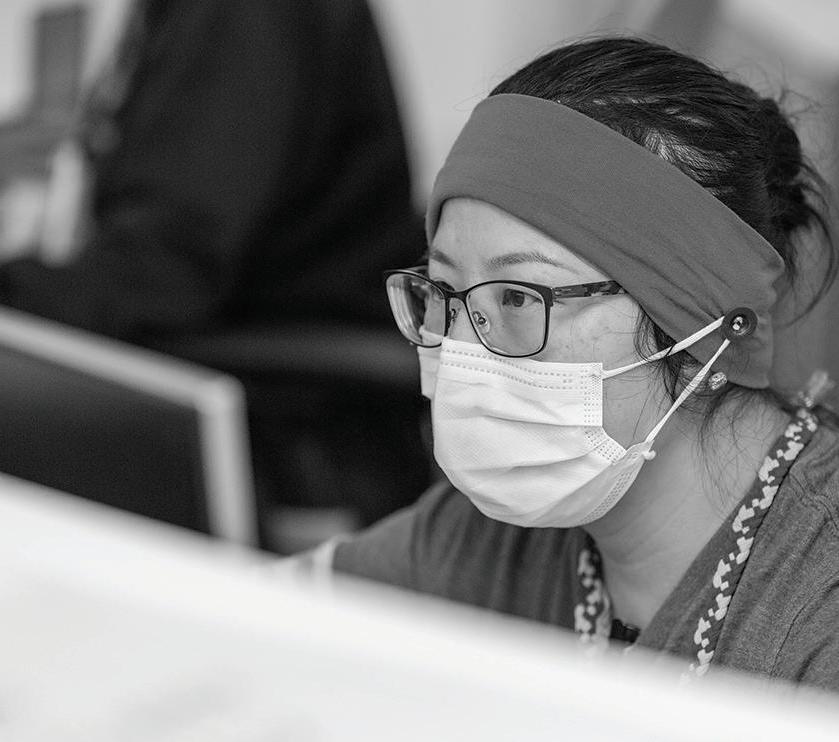




What does the future hold for the Nationwide Children's Nurse Residency? The Commission on Magnet® Recognition includes an option for provision of evidence of a nationally accredited transition to practice programs as fulfillment for Structural Empowerment 9 criteria. The Nationwide Children’s Nurse Residency Team is actively working toward accreditation of the program through the ANCC in 2020. We will also be looking to expand the program to include other areas not currently involved on main campus as well as off-site locations. NRPs are now becoming the norm and the benefits have made way for new programs to be created. Institutions across the country are piloting other programs including Leadership Residencies, APRN fellowships, RN fellowships (experienced RNs changing specialty), and Ambulatory NRPs. Other health care disciplines are also beginning to create Residency Programs. Stay tuned… the future is bright. Nationwide Children's is committed to support our new staff to continue on our Journey to Best Outcomes and demonstrating the One Team Values.








